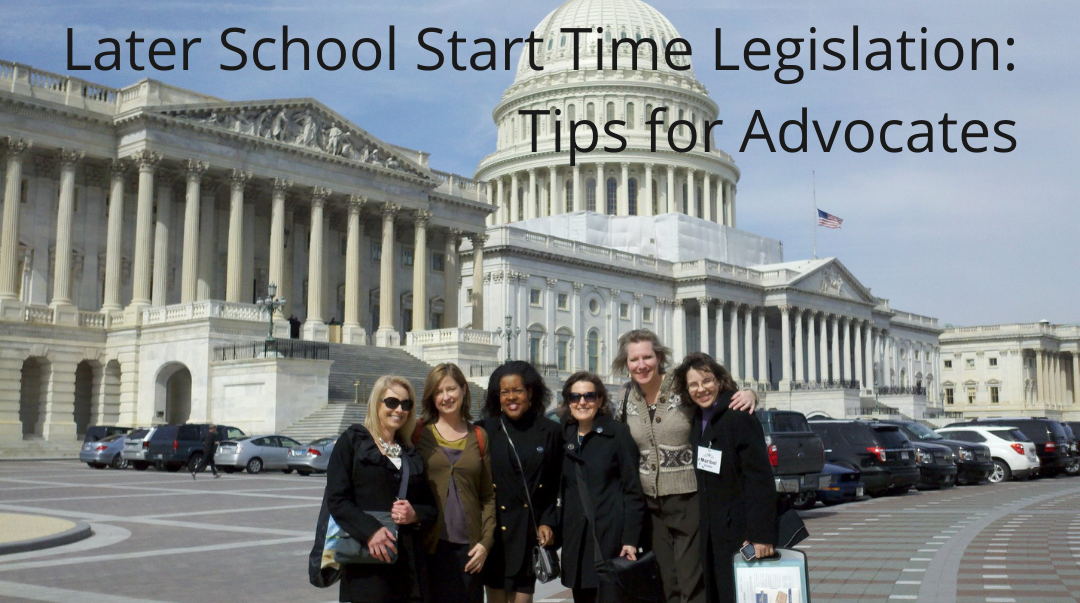|
Many school districts may need statewide legislation to spur or support later start times. Here's what you can do to help that happen. by Terra Ziporyn Snider, PhD Has your district still failed to ensure safe, healthy school hours? Join the club. Though any school district can establish sleep-friendly school hours on its own initiative--and many have--most still have not taken action. Despite clear calls for change since the 1990s, many school districts may need statewide legislation to spur or support later start times. Below are some advocacy tips that we've picked up over the years working for bills to study, incentivize, and even mandate sleep-friendly school start times. You can also find information on current legislative activity—as well as past success stories—on Start School Later's Legislation Page. Tip #1: Find an elected official to champion the cause To get your bill off the ground, you first want to find an elected official to introducing, or sponsoring, it. A bill can have numerous sponsors, often referred to as co-sponsors, but someone needs to get the ball rolling. Tip #2: Start with your own elected official(s) If that person or delegation won’t take the lead, it’s wise to pursue a legislator or several who serve on or lead committees that have the authority to work on health, educational or appropriations-related legislation Despite clear calls for change since the 1990s, many school districts may need statewide legislation to spur or support later start times. Tip #3: Determine if you or the legislator is taking the lead Some legislators will do the needed research and bill writing. Others will rely on you or other advocates to provide information, do research, and even draft bill language. Tip #4: Connect with Start School Later Ideally you should choose 1-2 representatives from your state or local Start School Later chapter who have the knowledge and time to be a resource and partner. The legislator can use Start School Later in getting support from both constituents and expert organizations likely to support the bill, Tip #5: Strive for bipartisan support Try to find legislative sponsors and subsequent "yes" votes in both legislative chambers (when there are two) and within both or all political parties, Emphasizing that it's much easier for local leaders to do the right thing (and deflecting community ire away from local school leaders) can be key. So can emphasizing that statewide parameters ensure that child's ability to go to school at sleep-friendly hours won't vary by zip code Tip #6: Neutralize the opposition
While advocates for healthy school hours see starting school later as a no-brainer, many people don’t. Any legislative effort for school hours change will attract the attention of individuals and organizations—including parents, teachers, school officials staff, and local businesses--that fear and thus oppose change. Some of these opponents have the type of financial resources and influence that community advocates just don't have, so it is important to find ways to neutralize their opposition. Try talking and compromising with them, using evidence to counter speculation and fear, or, if all else fails, minimizing publicity about the legislation until absolutely necessary, Tip #7: Build a base of supporters As an advocacy leader, you want to establishing an energized and committed base of supporters in place before introducing legislation. You need to be able to ask these supporters to supply written and oral testimony at legislative hearings and to contact legislators during key votes, sometimes with a very quick turnaround. An email list of people who support healthy teen sleep and sensible school start times can be invaluable here. Such supporters should be asked to take action by, for instance, signing an online petition; calling, writing to or visiting the offices of their legislators; writing letters to newspapers, posting on social media, and/or influencing others. Tip #8: Stress that local districts need help--and that they CAN make this work Stressing the need for help ensuring safe, healthy, equitable school hours—and the feasibility of doing so—is critical. Even if legislators agree that school should start at 8:30 or later, they will often reject legislation on the grounds that school hours should be decided locally ("local control") or that change isn't practical and/or affordable. That leads to a lot of agreeing that this "should be done" but also a lot of "kicking the can." Emphasizing that it's much easier for local leaders to do the right thing (and deflecting community ire away from local school leaders) can be key. So can emphasizing that statewide parameters ensure that child's ability to go to school at sleep-friendly hours won't vary by zip code Note: This blog was adapted from Start School Later materials originally put together by Debbie O. Moore Terra Ziporyn Snider, PhD, is the Executive Director and Co-Founder of Start School Later/Healthy Hours.
0 Comments
Your comment will be posted after it is approved.
Leave a Reply. |

 RSS Feed
RSS Feed